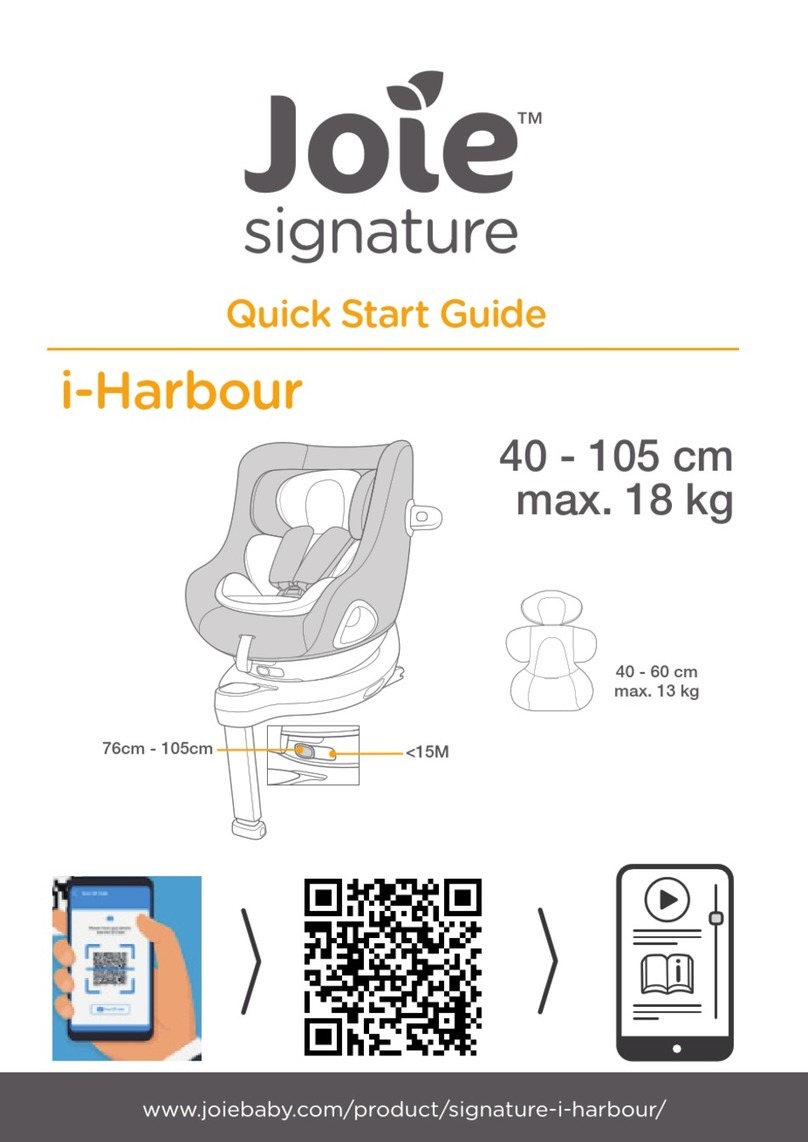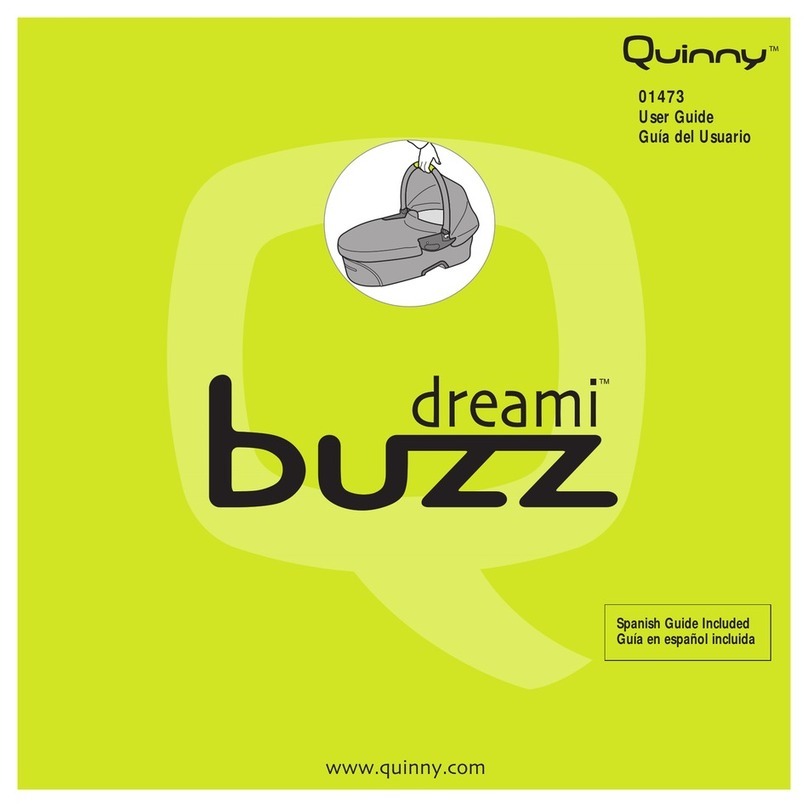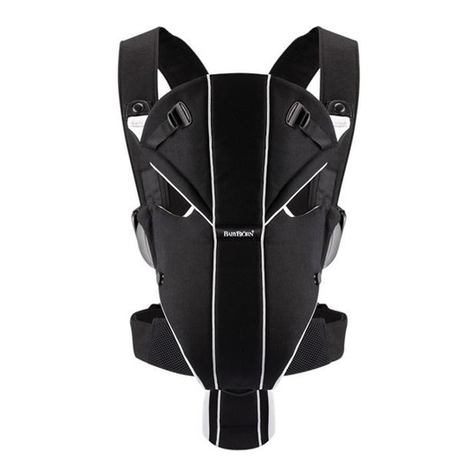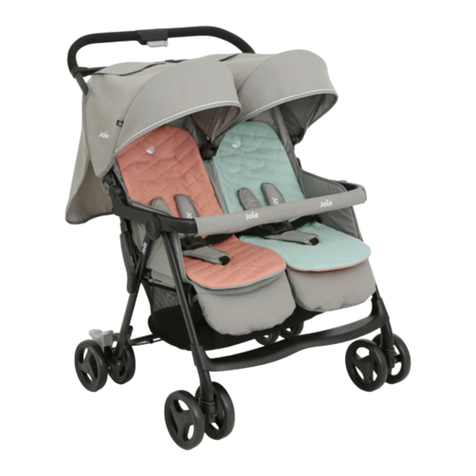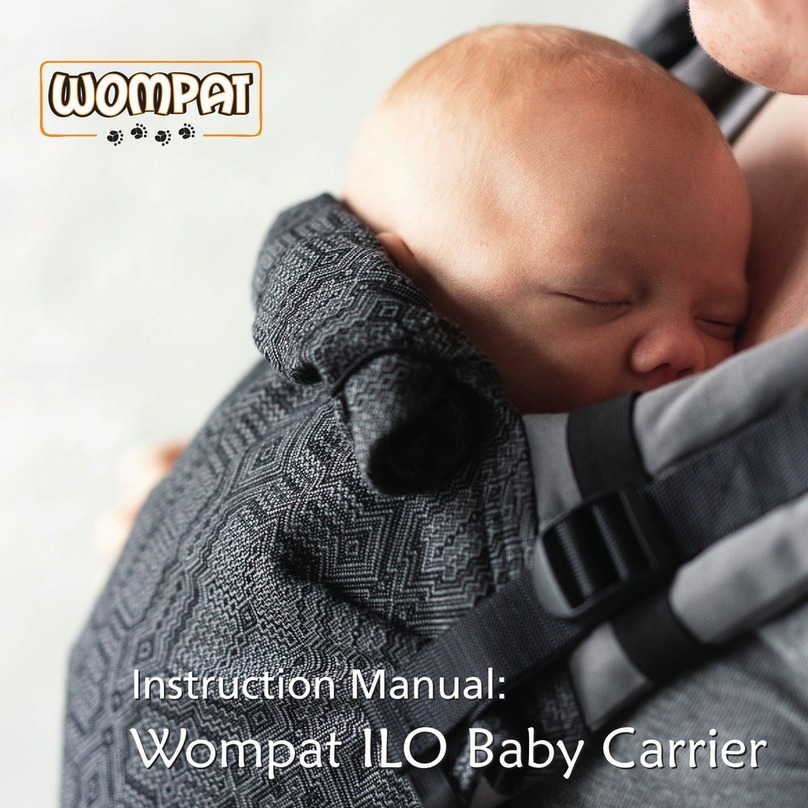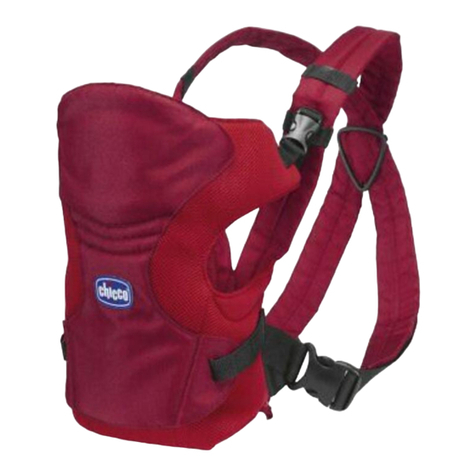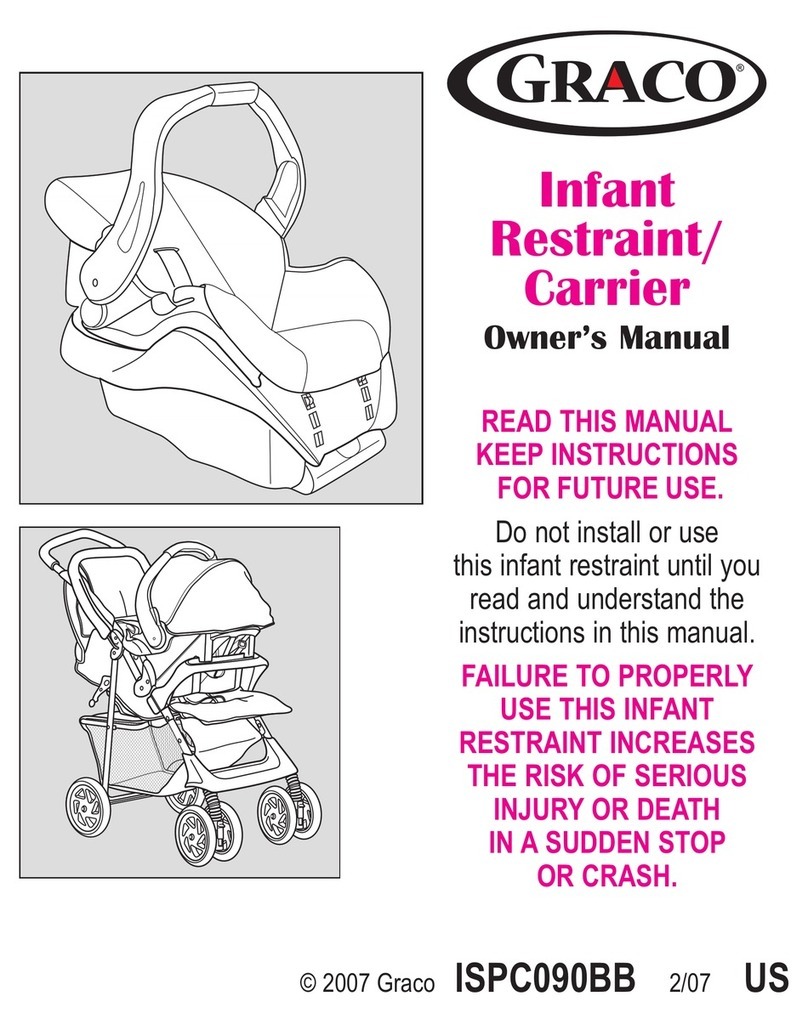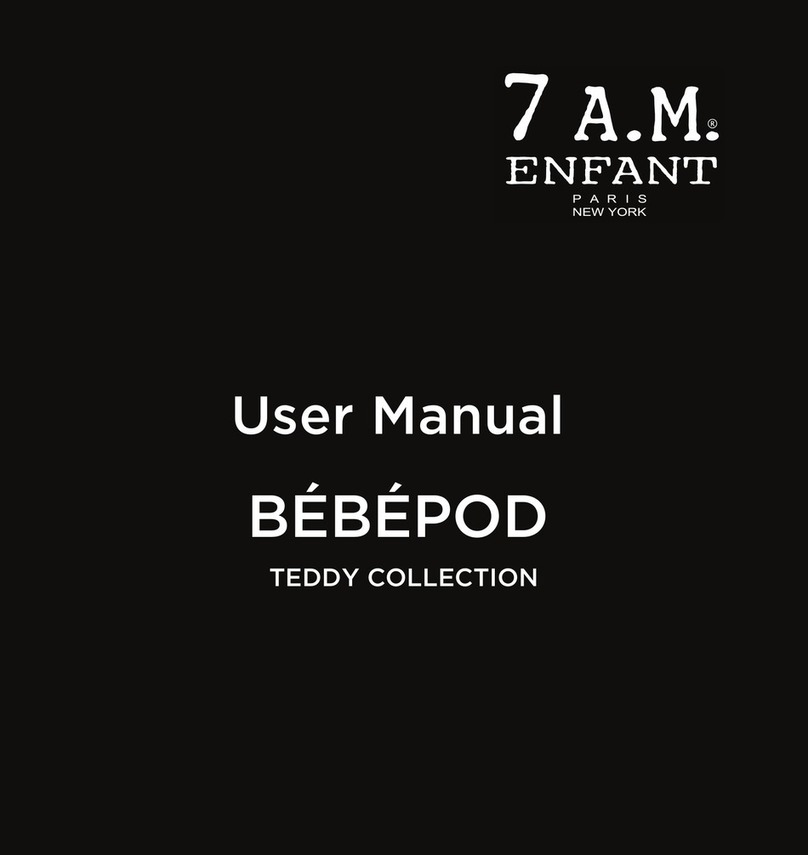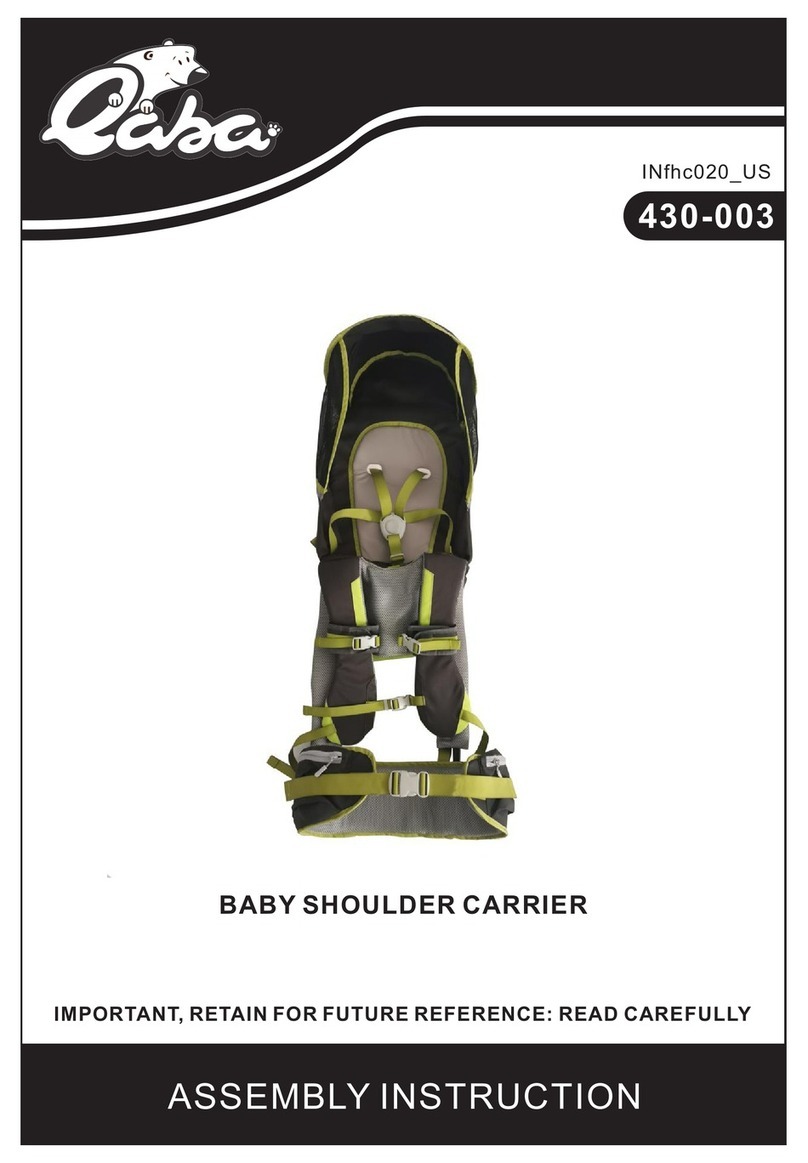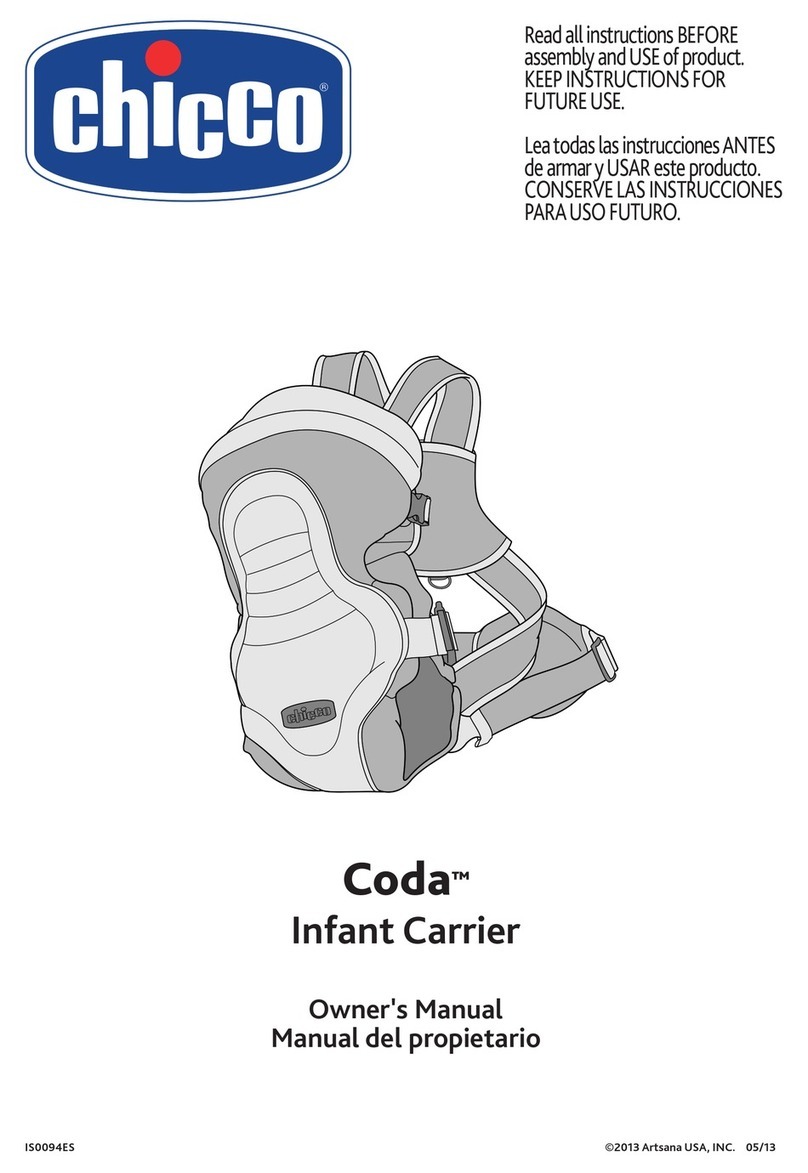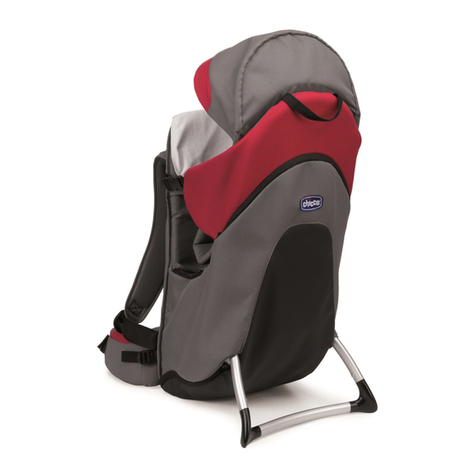deuter KID COMFORT ACTIVE User manual

Die deuter Kid Comfort Kindertrage bietet Ih-
nen den Vorteil TÜV SÜD/GS geprüfter Quali-
tät für Ihr Kind. Beachten Sie für die Sicher-
heit Ihres Kindes bei jeder Nutzung der Kid
Comfort Kindertragen bitte jedoch die unten
stehenden Punkte:
SICHERHEITSHINWEISE
ZUR NUTZUNG
BEDIENUNGSANLEITUNG FÜR DIE KINDERTRAGEN
KID COMFORT ACTIVE, KID COMFORT, KID COMFORT PRO
ACHTUNG! SORGFÄLTIG LESEN
UND FÜR SPÄTERES NACH
SCHLAGEN AUFBEWAHREN
WARNUNG–Nicht verwenden, bis das Kind selbständig sitzen kann! Das Kind
sollte sich bereits aus eigener Kraft in die Sitzposition begeben können
(etwa ab dem 9. Monat– kann individuell jedoch sehr unterschiedlich sein).
Die maximale Zuladung für die Kindertrage beträgt 24 kg
(Kind 22 kg + Gepäck 2 kg).
Transportieren Sie Ihr Kind nur angeschnallt und und unter Verwendung
der Fußschlaufen. Achten Sie darauf, dass der Sicherheitsgurt dabei
optimal für ihr Kind eingestellt ist (s. Schritt 3).
WARNUNG – Lassen Sie das Kind nicht unbeaufsichtigt in dieser Rücken-
trage mit Gestell sitzen! Die Kindertrage nicht auf erhöhte Flächen oder ab-
schüssiges Gelände stellen. Bei Pausen das Kind aus der Trage nehmen.
Längeres Sitzen kann das Kind ermüden und in seinen Beinen zur Ein-
schränkung der Blutzirkulation führen. Nutzen Sie deshalb die Fußstüt-
zen und legen Sie häufig Bewegungspausen ein.
WARNUNG – Die Kopfposition des in der Trage sitzenden Kindes ist
höher als die des Trägers. Deshalb Vorsicht bei niedrigen Ästen,
Türrahmen u.ä.
D
KidComfort_Booklet_Insert_22.indd 1KidComfort_Booklet_Insert_22.indd 1 02.03.21 16:3602.03.21 16:36

(Siehe Skizzen Umschlag vorne)
AAbnehmbares, handwaschbares
Kinnpolster ist angenehm weich.
Kid Comfort Pro, Kid Comfort: Kinnpols-
ter mit abnehmbarem, auswaschbarem Be-
zug. Die ergonomische Polsterform gibt dem
Köpfchen samt Oberkörper seitlich Halt und
stützt die Halswirbelsäule, wenn das Kind mü-
de nach vorne sinkt.
WARNUNG–Bei Verwendung der Trage muss
der Erwachsene auf Folgendes achten:
• Die Kid Comfort eignet ausschließlich für den
Transport von Kindern durch Erwachsene.
• Prüfen Sie die Kindertrage vor jedem Ge-
brauch auf Beschädigungen.
• Nutzen Sie die Kindertrage niemals in be-
schädigtem Zustand (verbogener Rahmen,
gebrochene Schnallen, offenen Nähten etc.).
• WARNUNG – Der Erwachsene, der das Kind
trägt, muss sehr vorsichtig sein, wenn er
sich nach vorne beugt oder lehnt.
• WARNUNG – Die Trage ist für die Nutzung
bei Freizeitaktivitäten geeignet, nicht je-
doch bei Sportaktivitäten wie Radfahren,
Skifahren oder ähnliches.
• Das in der Trage sitzende Kind leidet schnel-
ler und stärker unter Witterungseinflüssen
als der sich in Bewegung befindliche Er-
wachsene. Stellen Sie daher sicher, dass
das Kind entsprechendgekleidet ist und
prüfen unterwegs regelmäßig die Tempera-
tur seiner Hände und Füße.
• Das Kind darf sich nicht auf den Sitz der
Kindertrage stellen.
• Die empfindliche Kinderhaut ist vor Sonnen-
einstrahlung mit einem Sonnendach ab-
zuschirmen. Zusätzlich sollten Sie Ihr Kind
immer mit entsprechendem Sonnenschutz
vor Streulicht schützen!
• Stellen Sie die Kindertrage mit dem Kind
nicht auf Tischen oder erhöhten Flächen ab.
• Stürze oder Ausrutscher können zu ernst-
haften Verletzungen des Kindes führen.
• WARNUNG – Der Träger muss jeder Zeit da-
rauf gefasst sein, dass eine unerwarte-
te Bewegung, ob von ihm selbst oder dem
Kind, sein Gleichgewicht beeinträchtigt.
• Es sollte darauf geachtet werden, Verlet-
zungen der Füße des Kindes zu vermeiden,
wenn die Trage abgestellt wird bzw. die
Trage am oder nahe dem Boden ist.
• WARNUNG – Beim Aufsetzen und Absetzen
der Trage ist mit Vorsicht vorzugehen.
• Der Rucksack der Kid Comfort Pro darf aus-
schließlich von Erwachsenen verwendet wer-
den. Durch die langen Gurtbänder besteht
für Kinder Strangulationsgefahr.
Bei Nichtbeachtung dieser Hinweise kann es zu
Verletzungen, dauerhaft körperlichen Schädi-
gungen oder sogar zum Tod des Kindes führen.
FUNKTIONEN
KidComfort_Booklet_Insert_22.indd 2KidComfort_Booklet_Insert_22.indd 2 02.03.21 16:3602.03.21 16:36

BDas ergonomisch geformte, gepolster-
te Sicherheitsgurtsystem garantiert
höchste Sicherheit. Unvorhergesehene, weite
Bewegungen des Kindes, die den Träger aus
der Balance bringen könnten, werden vermie-
den. Durch seitlich angeordnete, farbig ge-
kennzeichnete Schnallen ist er schnell ver-
ständlich, einfach bedienbar und sehr gut er-
reichbar. Die Höhe ist mühelos anpassbar
auch wenn das Kind schon sitzt.
(3. 5-Punkt-Sicherheitsgurt anpassen)
CMit zwei stabilen Handgriffen kann die
Trage mit Kind vom Träger allein auf
den Rücken gehoben und abgesetzt werden.
(6. Kindertrage auf- und absetzen)
DDie Sonnendachoption gibt die Mög-
lichkeit, insbesondere im Hochsom-
mer und im Gebirge, die empfindliche
Kinderhaut vor starker Sonneneinstrahlung
abzuschirmen. Sonnendach bei Kid Comfort
Active als Accessoire erhältlich, bei Kid Com-
fort mitgeliefert, bei Pro fest integriert.
(5. Sonnen- und Regendach anbringen)
EMit dem höhenverstellbaren Sitz be-
findet sich das heranwachsende Kind
immer in der idealen Position: das Kinn auf
Höhe der oberen Hälfte des Kinnpolsters.
Die Breite des Sitzpolsters variiert in Relati-
on zur eingestellten Höhe und ermöglicht in
Verbindung mit den Fußstützen eine alters-
gerechte gesunde Sitzhaltung: Je höher ein-
gestellt, desto breiter ist der Sitz für eine na-
türliche Anhock-Spreiz-Haltung, je tiefer ab-
gelassen, desto schmäler wird er für eine
aufrechte Sitzposition.
(2. Höhe des Kindersitzes einrichten)
FDen einfachen und sicheren Zustieg
über die Seite nutzen die Kinder mit
Begeisterung, um selbst in die Trage zu
schlüpfen. Auch das Hineinheben wird da-
durch wesentlich leichter und sicherer.
GHöhenverstellbare Fußstützen fördern
die Durchblutung der Kinderbeine,
damit diese länger warm bleiben und nicht
einschlafen. Die Fußstützen sind beweglich an-
gebracht. Das Kind kann also spielerisch sei-
ne Bein- und Sitzposition ändern, gleichzeitig
aber mit deren Hilfe nicht aufstehen. So wird
das Aufschaukeln beim Tragen oder das Kip-
pen der stehenden Kraxe wirksam verhindert.
(4. Höhe der Fußstützen einrichten)
HDer standfeste Aluminium-Rahmen
mit seinem breiten Klappfuß ist beim
Ein- und Aussteigen von großem Vorteil.
IPerfekt abgestimmte Rückensysteme ga-
rantieren deuter typischen Tragekomfort:
LITE AIR SYSTEM
Leichte und luftige Konstruktion mit perfek-
ter Lastübertragung: Der extrem leichte, mi-
nimalistische Kontaktrücken ist direkt mit
dem Rahmengestell verbunden und garan-
tiert so perfekte Lastübertragung und Kon-
trolle bei niedrigstem Gewicht. Das Lite Air
Rückenpanel sitzt kompakt, ist durch seine
Struktur aber angenehm belüftet.
AIRCOMFORT SENSIC VARIO
Perfekte Lastübertragung bei maximaler
Belüftung: Das Sensic System nutzt innova-
tiv den Leerraum zwischen dem Kindersitz
und dem Rücken des Trägers. Hier schafft
das Aircomfort-Netz einen Ventilationsraum,
D
KidComfort_Booklet_Insert_22.indd 3KidComfort_Booklet_Insert_22.indd 3 02.03.21 16:3602.03.21 16:36

(Siehe Skizzen Umschlag hinten)
1Tragesystem
anpassen
1.1 Zuerst sämtliche Riemen lockern. Kinder-
trage mit realistischem Gewicht, jedoch nicht
mit dem Kind selbst, beladen und schultern.
1.2 Hüftflossen mittig auf den Beckenkno-
chen platzieren und zuziehen.
1.3 Anschließend Schulterträger nur so
festziehen, dass das Hauptgewicht weiterhin
mit den Hüftflossen getragen wird.
1.4 Idealerweise liegt der Trägeransatz zwi-
schen den Schulterblättern. Um diese Position
einzustellen die Schulterträger über die Rücken-
längen-Anpassung höher oder tiefer platzieren:
1.5.1 VariSlide: Blitzschnell lässt sich die
Rückenlänge durch dieses System perfekt
und stufenlos genau anpassen. Dazu die zen-
tral am Rückensystem angebrachte Kunst-
stoffschnalle anheben a). Gleichzeitig die
Schulterträger in die passende Position zie-
hen oder schieben b).
1.5.2 VariQuick: Das Klettband am Träger-
herz öffnen und durch die passenden 4 Be-
über den die feuchte Luft ungehindert abzie-
hen kann. Der Schwerpunkt des Kindes bleibt
dabei in der gleichen Position wie bei einer
Kraxe mit Kontaktrücken. Das Tragesystem
ist direkt mit dem Rahmen der Kraxe verbun-
den. Die Vorteile sind enorm: Die ergonomi-
sche Kraxe sitzt perfekt und die Last wird op-
timal, weil körpernah, übertragen. Durch das
Spezialnetz genießt der Träger zugleich maxi-
male Belüftung.
JFür besten Tragekomfort schmiegen
sich S-förmige Schulterträger, formsta-
bil und mit luftigem 3D AirMesh bezogen, den
Schultern an.
KDank PullForward Verstellung sind die
Hüftflossen auch bei voller Ladung
leicht festzuziehen. Kid Comfort, Kid Comfort
Pro: Bewegliche Variflex ECL Hüftflossen um-
schließen mit ihren ergonomischen Polster-
einsätzen förmlich die Hüften und folgen je-
der Bewegung. Das Gewicht wird gleichmäßig
auf dem kräftigen Becken verteilt. Treppen,
unebene Pfade oder steilere Anstiege lassen
sich auf diese Weise Kraft sparend meistern.
LDamit beide Elternteile die Kraxe
angenehm tragen können, ist die
Rückenlänge mit wenigen Handgriffen genau
anpassbar. (1. Tragesystem anpassen)
BEDIENUNG
KidComfort_Booklet_Insert_22.indd 4KidComfort_Booklet_Insert_22.indd 4 02.03.21 16:3602.03.21 16:36

festigungsschlaufen führen a). Danach
Klettband festziehen und wieder fixieren b).
1.6 Nun den Winkel der Lageverstellriemen
anpassen: Rückenlänge S-M untere, M-L obe-
re Schnallen einfädeln. Durch Festziehen der
Lageverstellriemen an Schulterträgern und
Hüftflossen bekommt die Kindertrage enge-
ren Kontakt zum Rücken. Das sorgt für mehr
Stabilität in schwierigem Terrain. Für mehr
Belüftung etwas lockern.
Ist das Tragesystem an die Rückenlänge des
Trägers angepasst, die Kindertrage wieder
abnehmen und mit dem Einrichten der Sitz-
höhe fortfahren.
2Höhe des Kinder-
sitzes einrichten
2.1 Die Trage zum Einrichten auf dem Boden
absetzen. Die Riemen der Seitenflügel lockern
und den seitlichen Zustieg öffnen. 5-Punkt-Si-
cherheitsgurt ebenfalls lockern und öffnen.
2.2 Den Kindersitz nun vollständig absen-
ken. Dazu das Kinnpolster nach oben klappen,
die Sitzhöhen-Einstellschnalle anheben und
den Sitz mit der Hand nach unten drücken.
2.3 Stellen Sie sich an die Rückseite der
Trage und kontrollieren, ob diese stabil steht.
Zum Sichern der Trage während der weite-
ren Anpassungsschritte immer einen Fuß auf
dem Klappfuß platzieren.
2.4 Sie können nun das Kind in die Trage
heben oder es mit Unterstützung selbst über
die Seite einsteigen lassen. Führen Sie die
Arme ihres Kindes durch die Schulterträger
des Sicherheitsgurtes und schließen dessen
Brustgurt.
2.5 Die Sitzhöhe ist dann optimal, wenn das
Kind gut aus der Trage hinaussehen und die
Arme möglichst frei bewegen kann. Um den
Sitz in die ideale Höhe anzuheben den Einstell-
gurt soweit anziehen bis sich das Kinn des
Kindes knapp über der Schnalle für die Sitzhö-
heneinstellung befindet. Eine Hand unterstützt
dabei von unten die Bewegung des Sitzes.
35-Punkt-Sicherheits-
gurt anpassen
3.1 Nachdem sich der Kindersitz jetzt in
der idealen Höhe befindet, stecken Sie die
beiden Schließen des 5-Punkt-Sicherheitsg-
urtes in die seitlich am Sitz befindlichen, far-
big gekennzeichneten Schnallen.
3.2 Der Schulterträgeransatz des Sicher-
heitsgurtes sollte zwischen den Schulterblät-
tern des Kindes liegen: Greifen Sie hinter den
Rücken des Kindes, lösen das Klettband des
Trägerherzes und drücken es an der entspre-
chenden Position wieder an.
3.3 Dann die Schulterträger des 5-Punkt-
Sicherheitsgurtes eng aber nicht zu fest an-
ziehen. Kinnpolster nach unten klappen.
3.4 Seitlichen Zustieg schließen und an den
beiden Seitenflügeln die Riemen anziehen.
D
KidComfort_Booklet_Insert_22.indd 5KidComfort_Booklet_Insert_22.indd 5 02.03.21 16:3602.03.21 16:36
This manual suits for next models
2
Table of contents
Languages:
Other deuter Baby Carrier manuals




